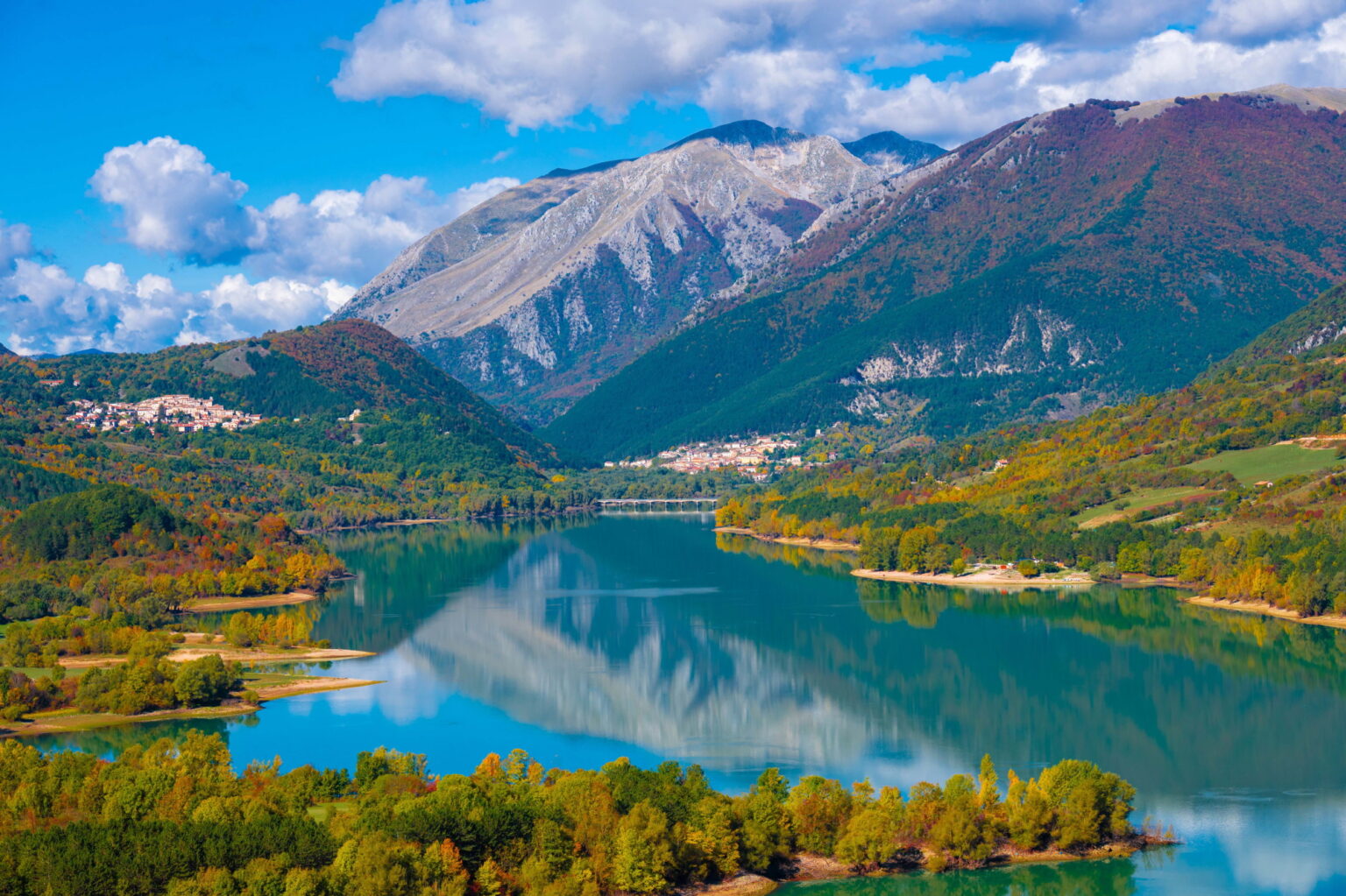

Our fully renovated historic hotel is just a few kilometres from Pescara. Overlooking a beautiful beach on the Adriatic Riviera, the property provides the perfect setting for entertainment and relaxation for all ages.


Between towering mountains cloaked in unspoiled forests and valleys studded with picturesque villages, Abruzzo is an extraordinary land to explore and get closer with nature. The region’s rich history and national parks never fail to enchant, as does the sea–Abruzzo’s golden coastline is on the exquisite Adriatic Sea. The silence from nature undercuts the dynamism of the city centre to make for an unforgettable setting.
Old Pescara, the city’s beating heart, is between Corso Manthonè and Via delle Caserme–it’s abuzz day and night year-round, as evidenced by the late-night restaurants and clubs that line the pedestrian streets. The city is home to Gabriele D’Annunzio’s Birthplace Museum, which documents the poet’s life and work, and the Museum of the People of Abruzzo, which looks at the history and folk traditions from their origins to the 1950s. The 19th-century Villa Urania, near Piazza Salotto in Pescara’s modern centre, is home to Antiche Maioliche di Castelli, a museum with an important local ceramic collection. Downtown Pescara is the place to shop–you’ll find several designer outlets in the Montesilvano and Città Sant’Angelo shopping areas.
Città Sant’Angelo is home to the 12th-century Collegiate Church of Saint Michael and the churches of Saint Clare and Saint Francis. You’ll find other noteworthy artistic sites in Atri, about 20 km away, like Acquaviva Palace, the Municipal Theatre, the church of Saint Augustine, and the 14th-century Fonte Canale and Caves, a mighty network of interconnected opus signum caves.
Lake Penne, home to the Oasis Farm, is one of the region’s most intriguing wildlife oases. At Penne Reserve farm, workers experiment with producing and processing organic farm products. Clients of all ages can participate in the Oasis workshop to learn typical local activities, such as woodworking and ceramics.
Chieti, 330 metres (330 feet) above sea level, rests on a hill that divides the Pescara River tributary from the Alento basin. Further along, it separates the Majella and Gran Sasso mountain masses from the Adriatic Sea plains—have your camera ready. One of Italy’s most fascinating old cities, Chieti is home to the National Archaeological Museum, which recounts the most significant phases of Abruzzo’s archaeological history—don’t miss the Capestrano Warrior statue, which dates to the 5th century B.C. There’s also the Civitella Museum, which exhibits Palaeolithic and Neolithic artefacts.
Gran Sasso National Park spans 160,000 hectares, completely enveloping the Gran Sasso and Monti della Laga mountain ranges. The park’s flora reflects its valuable plant heritage, while rare species like the Apennine wolf, wild cat, chamois, wild boar, squirrels, and foxes represent its diverse fauna. A dense network of hiking trails and the Gran Sasso Horse Trail weave through the park, so it’s easy to explore by mountain bike. Well-preserved mediaeval villages, rural architecture, castles, hermitages, and abbeys lie nearby.
Situated on a hill that slopes toward the sea, Vasto retains several relics from its past: Augustan villa remains and traces of mediaeval settlements, the 15th-century Caldoresco Castle, and the Palazzo d’Avalos. Located in Piazza Prudente, the Palazzo bears decorative details from the remains of the 14th-century villa on which it was built. On Vasto’s coast, admire the Trabocchi, ancient wood fishing structures.
Majella National Park covers the provinces of L’Aquila, Chieti, and Pescara and as many as 34 other municipalities. The park’s mighty limestone massif is cut by the canyons of Orfento, Selva Romana, Santo Spirito, and Val Serveria. Its diverse fauna includes rare species like the Apennine wolf, wild cat, and chamois. The park organises various visitor activities, such as hiking, mountain-biking, horseback riding, guided educational tours, trekking, birdwatching, cycling, rock climbing, and canyoning.
At Abruzzo National Park, you can immerse yourself in genuine nature, culture, traditions, and the different environments that characterise them. From its rounded peaks to the typical soaring Apennine slopes, the park is home to some of Italy’s most interesting fauna: the brown bear, chamois, and wolf. Expert guides lead hiking and mountain bike tours through the park’s quietest, most stunning locations. There are also several places to enjoy typical Abruzzese cuisine.
Situated inside the Gran Sasso and Monti della Laga National Park, Campo Imperatore is a vast plateau of glacial origin that soars to nearly 1,800 metres above sea level. It stands in the heart of the Gran Sasso d’Italia massif in the province of L’Aquila and is famous for the astronomical observatory built in 1948. Numerous hiking trails leave from the plateau, including Ippovia del Gran Sasso, a famous 300 km route that’s the longest of its kind in Italy. Campo Imperatore is also home to one of Italy’s highest ski resorts.
Three islands comprise this exquisite archipelago: San Domino, San Nicola, and Caprara. The crystal-clear sea and rocky seabed render it especially popular with divers. Once at the islands, you can rent rubber dinghies and boats to explore the multitude of inlets and coves.
A sparkling sea, urban vibrancy, and a warm atmosphere
Old Pescara, the city’s beating heart, is between Corso Manthonè and Via delle Caserme–it’s abuzz day and night year-round, as evidenced by the late-night restaurants and clubs that line the pedestrian streets. The city is home to Gabriele D’Annunzio’s Birthplace Museum, which documents the poet’s life and work, and the Museum of the People of Abruzzo, which looks at the history and folk traditions from their origins to the 1950s. The 19th-century Villa Urania, near Piazza Salotto in Pescara’s modern centre, is home to Antiche Maioliche di Castelli, a museum with an important local ceramic collection. Downtown Pescara is the place to shop–you’ll find several designer outlets in the Montesilvano and Città Sant’Angelo shopping areas.
A jewel nestled into golden hills
Città Sant’Angelo is home to the 12th-century Collegiate Church of Saint Michael and the churches of Saint Clare and Saint Francis. You’ll find other noteworthy artistic sites in Atri, about 20 km away, like Acquaviva Palace, the Municipal Theatre, the church of Saint Augustine, and the 14th-century Fonte Canale and Caves, a mighty network of interconnected opus signum caves.
Organic farming in a wildlife oasis
Lake Penne, home to the Oasis Farm, is one of the region’s most intriguing wildlife oases. At Penne Reserve farm, workers experiment with producing and processing organic farm products. Clients of all ages can participate in the Oasis workshop to learn typical local activities, such as woodworking and ceramics.
ONE OF ITALY’S OLDEST CITIES WITH FASCINATING ORIGINS
Chieti, 330 metres (330 feet) above sea level, rests on a hill that divides the Pescara River tributary from the Alento basin. Further along, it separates the Majella and Gran Sasso mountain masses from the Adriatic Sea plains—have your camera ready. One of Italy’s most fascinating old cities, Chieti is home to the National Archaeological Museum, which recounts the most significant phases of Abruzzo’s archaeological history—don’t miss the Capestrano Warrior statue, which dates to the 5th century B.C. There’s also the Civitella Museum, which exhibits Palaeolithic and Neolithic artefacts.
A wild, evocative embrace
Gran Sasso National Park spans 160,000 hectares, completely enveloping the Gran Sasso and Monti della Laga mountain ranges. The park’s flora reflects its valuable plant heritage, while rare species like the Apennine wolf, wild cat, chamois, wild boar, squirrels, and foxes represent its diverse fauna. A dense network of hiking trails and the Gran Sasso Horse Trail weave through the park, so it’s easy to explore by mountain bike. Well-preserved mediaeval villages, rural architecture, castles, hermitages, and abbeys lie nearby.
A village framed by the turquoise sea
Situated on a hill that slopes toward the sea, Vasto retains several relics from its past: Augustan villa remains and traces of mediaeval settlements, the 15th-century Caldoresco Castle, and the Palazzo d’Avalos. Located in Piazza Prudente, the Palazzo bears decorative details from the remains of the 14th-century villa on which it was built. On Vasto’s coast, admire the Trabocchi, ancient wood fishing structures.
A sanctuary of majestic peaks and millennial-old forests
Majella National Park covers the provinces of L’Aquila, Chieti, and Pescara and as many as 34 other municipalities. The park’s mighty limestone massif is cut by the canyons of Orfento, Selva Romana, Santo Spirito, and Val Serveria. Its diverse fauna includes rare species like the Apennine wolf, wild cat, and chamois. The park organises various visitor activities, such as hiking, mountain-biking, horseback riding, guided educational tours, trekking, birdwatching, cycling, rock climbing, and canyoning.
For lovers of nature and unspoiled spaces
At Abruzzo National Park, you can immerse yourself in genuine nature, culture, traditions, and the different environments that characterise them. From its rounded peaks to the typical soaring Apennine slopes, the park is home to some of Italy’s most interesting fauna: the brown bear, chamois, and wolf. Expert guides lead hiking and mountain bike tours through the park’s quietest, most stunning locations. There are also several places to enjoy typical Abruzzese cuisine.
A wild green carpet among the peaks of the Gran Sasso
Situated inside the Gran Sasso and Monti della Laga National Park, Campo Imperatore is a vast plateau of glacial origin that soars to nearly 1,800 metres above sea level. It stands in the heart of the Gran Sasso d’Italia massif in the province of L’Aquila and is famous for the astronomical observatory built in 1948. Numerous hiking trails leave from the plateau, including Ippovia del Gran Sasso, a famous 300 km route that’s the longest of its kind in Italy. Campo Imperatore is also home to one of Italy’s highest ski resorts.
A hidden paradise in the heart of the Adriatic Sea
Three islands comprise this exquisite archipelago: San Domino, San Nicola, and Caprara. The crystal-clear sea and rocky seabed render it especially popular with divers. Once at the islands, you can rent rubber dinghies and boats to explore the multitude of inlets and coves.
Enter the world of Bluserena. Sign up to receive email updates
on news, stories, and great holiday deals.